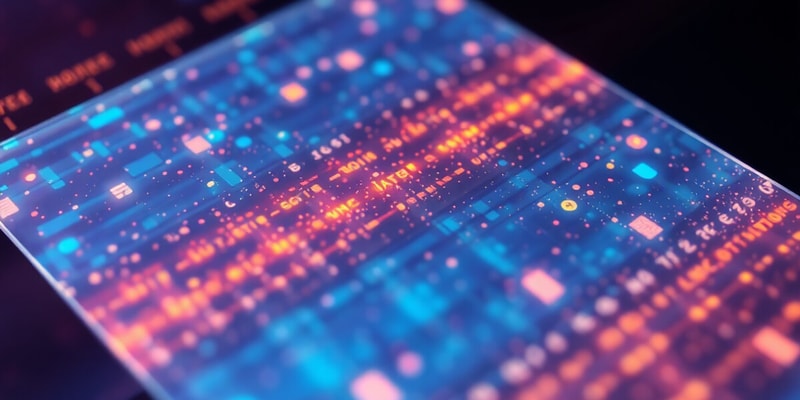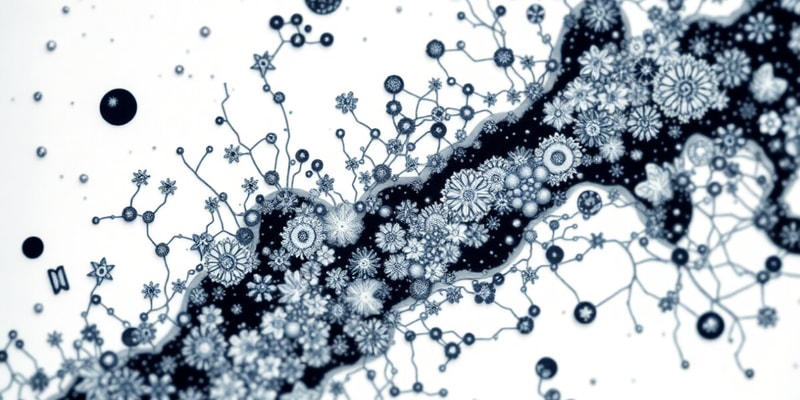Podcast
Questions and Answers
What is the primary purpose of boiling the samples at 70°C for 2 minutes?
What is the primary purpose of boiling the samples at 70°C for 2 minutes?
What is the role of Laemmli Sample Buffer in the preparation of protein samples?
What is the role of Laemmli Sample Buffer in the preparation of protein samples?
Which electrode in the electrophoretic apparatus should be connected to the bottom chamber?
Which electrode in the electrophoretic apparatus should be connected to the bottom chamber?
What is the primary purpose of using sodium dodecyl sulfate (SDS) in the SDS-PAGE technique?
What is the primary purpose of using sodium dodecyl sulfate (SDS) in the SDS-PAGE technique?
Signup and view all the answers
In SDS-PAGE, the migration of proteins occurs from which electrode to which electrode?
In SDS-PAGE, the migration of proteins occurs from which electrode to which electrode?
Signup and view all the answers
How long should the gels typically run during the electrophoresis process?
How long should the gels typically run during the electrophoresis process?
Signup and view all the answers
Which of the following components is NOT included in the Laemmli Sample Buffer preparation?
Which of the following components is NOT included in the Laemmli Sample Buffer preparation?
Signup and view all the answers
What potential hazard is associated with 2-mercaptoethanol found in the Laemmli Sample Buffer?
What potential hazard is associated with 2-mercaptoethanol found in the Laemmli Sample Buffer?
Signup and view all the answers
What occurs to high molecular weight proteins during SDS-PAGE?
What occurs to high molecular weight proteins during SDS-PAGE?
Signup and view all the answers
What is the expected outcome if gels are overheated during electrophoresis?
What is the expected outcome if gels are overheated during electrophoresis?
Signup and view all the answers
What step follows the addition of Coomassie Blue staining solution?
What step follows the addition of Coomassie Blue staining solution?
Signup and view all the answers
Which property of SDS allows it to effectively denature proteins in the sample?
Which property of SDS allows it to effectively denature proteins in the sample?
Signup and view all the answers
Which reducing agent is commonly used in conjunction with SDS for protein denaturation?
Which reducing agent is commonly used in conjunction with SDS for protein denaturation?
Signup and view all the answers
What is crucial to do before removing the gels after electrophoresis?
What is crucial to do before removing the gels after electrophoresis?
Signup and view all the answers
What is the role of the protein ladder in SDS-PAGE?
What is the role of the protein ladder in SDS-PAGE?
Signup and view all the answers
During gel analysis in SDS-PAGE, what is the expected location of albumin with a molecular weight of 66.5 kDa compared to casein with a molecular weight of 24 kDa?
During gel analysis in SDS-PAGE, what is the expected location of albumin with a molecular weight of 66.5 kDa compared to casein with a molecular weight of 24 kDa?
Signup and view all the answers
Study Notes
MD100 Medical Biochemistry I - Lab Exercise 3: Introduction to SDS PAGE
- Course: Medical Biochemistry I
- Lab Exercise: Introduction to SDS PAGE, Protein Identification and Characterization
- Semester: Fall 2024
- Institution: European University Cyprus, School of Medicine
Objectives
- Introduction: SDS-PAGE laboratory technique
- Theoretical Background: Principle of SDS-PAGE
- Part A: Sample preparation - dilutions
- Part B: Sample loading - Running the gel
- Part C: Gel staining and destaining
- Part D: Protein gel analysis - protein identification
Introduction to SDS-PAGE
- Technique: Used to separate proteins based on molecular weight
- Electrophoresis: Separation of macromolecules in an electric field
- Support Medium: Discontinuous polyacrylamide gel
- Denaturing Agent: Sodium dodecyl sulfate (SDS)
- Principle: SDS binds to proteins, giving them a uniform negative charge, making protein migration dependent on size
- Reducing Agent: β-mercaptoethanol cleaves disulfide bonds and helps to unfold proteins
- Migration: Proteins migrate towards the anode (+ electrode)
The Principle of SDS-PAGE
- Proteins: Initially folded with positive and negative charges
- Reduction: Disulfide bonds are reduced by 2-mercaptoethanol
- Linear Structure: Unfolded to a linear structure, with a negative charge proportional to the polypeptide chain length.
The Principle of SDS-PAGE (continued)
- Migration: High molecular weight proteins migrate slower, while low molecular weight proteins migrate faster. Proteins migrate from the cathode (-) to the anode (+).
Protein Identification
- Albumin: Molecular weight: 66.5 kDa
- Casein: Molecular weight: 24 kDa
Materials/Equipment
- Gels: Prepared in the lab or precast
- Vertical Gel Electrophoresis Chamber
- Protein Samples
- Running Buffer (Tris/Glycine/SDS)
- Staining and Destaining Buffer
- Protein Ladder: Prestained protein molecular weight standards
- Micropipettes and gel loading tips
- Laemmli Sample Buffer
Sample Preparation
- Dilutions: Prepare 5%, 2.5%, and 1% dilutions from starting 10% unknown protein solutions.
- Laemmli Sample Buffer: 1/4 volume of total sample volume, and include the following: Tris-HCI pH 6.8, SDS, Glycerol, 2-mercaptoethanol, Bromophenol Blue.
- Heating: Heat protein samples immediately after adding Laemmli buffer to prevent protease degradation.
Protocol
- Dilutions: Prepare dilutions of the unknown protein samples.
- Sample Preparation: Combine protein sample with Laemmli buffer
- Heat Samples: Completely denature the proteins for 2 minutes at 70°C
- Add Buffer: Add running buffer to gel electrophoresis chambers.
- Load Protein Ladder: Load 10µl of Protein Ladder at the first well
- Load Samples: Load 10 µl per sample in the remaining wells.
- Run Gels: Run gels at 180 volts.
- Stop the Run: Stop when the dye front is near the bottom of the gel.
- Gel Removal: Turn off power supply and disconnect cables.
- Gel Stains: Soak the separated gel in Commassie Blue stain for 15 minutes on a rocking table.
- Gel Destain: Rinse and destain the gel, adding fresh destain solution for additional 15 minute incubation and changing every 5 minutes (total 2 changes). Overnight incubation with de-ionized water.
- Picture: Take pictures of the gels
Protein Gel Analysis
- Bands: Single band implies only one protein, multiple bands imply multiple proteins or protein subunits
- Identification: Use protein ladder to identify proteins.
- Concentration Estimation: Relative band darkness implies relative protein concentration. Size comparisons will determine relative concentration.
Protein Ladder
- Molecular weight markers: Used to determine the protein's approximate molecular weight.
Question 1
- Correct Answer: C. Smaller proteins migrate more rapidly through the gel
Question 2
- Correct Answer: A. Staining them with the dye
Results
- Gel Image: A gel image showing multiple bands with molecular weight information.
Studying That Suits You
Use AI to generate personalized quizzes and flashcards to suit your learning preferences.
Related Documents
Description
This quiz explores the fundamentals of the SDS-PAGE laboratory technique covered in Medical Biochemistry I. Students will understand sample preparation, gel loading, staining, and analysis for protein identification. Perfect for those enrolled in the Fall 2024 semester at the European University Cyprus, School of Medicine.




